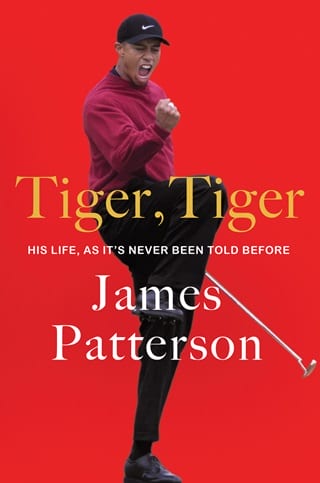Chapter 42
Tiger Woods Foundation Junior Golf Clinic and Exhibition
James E. Stewart Golf Course
Oklahoma City, Oklahoma
May 7, 2000
Kids are on Tiger’s mind.
Not his own—he denies reports of a Valentine’s Day engagement to his girlfriend, Joanna Jagoda, and in answer to reporter Stuart Scott’s question “Do you want little Tigers running around?” he replies, “A yellow Lab. That’s fine. A Rottweiler.” Today, he’s focused on bringing the sport he loves to kids, especially those who might not otherwise try it out.
From the top of the driving range, golf carts motor in formation to the beat of rock music. The thumping bass line pumps up the bleacher seats, filled with twenty-five hundred kids from Oklahoma City youth programs who can’t wait to watch Tiger Woods hit some golf balls.
The carts pull up to the practice tee. Under the protective watch of well-muscled bodyguards, Tiger and Earl step out.
At the St. John’s Missionary Baptist Church morning service, Earl got emotional while giving a talk to the all-Black congregation on the theme of “share and care,” the family motto. Those are the bywords of the Woods family and the basis of the Tiger Woods Foundation, which Tiger, Earl, and Tida founded in November of 1996, shortly after Tiger turned pro. The charitable organization has a strong educational mission as well as an inspirational component.
The goal, as Tiger describes it, is “to make golf look more like America.”
These young Americans are hoping for a demonstration of the awesome juggling skills Tiger showed in last year’s instantly famous Nike commercial. Tiger picks up his sand wedge, the same club he used to film the spot.
“I heard a rumor that this thing I did on TV was all computerized,” he tells the kids. “It’s kind of a vicious rumor.”
The kids are mesmerized as Tiger bounces the ball on the face of the club, then moves the club between his legs, keeping the ball in constant contact with the club, all the while effortlessly narrating: “I don’t know where that rumor started, whether it was the public or the press, but they obviously hadn’t seen me do this before.”
No one in the bleachers moves or speaks as Tiger works the club left-handed, right-handed, then bounces the ball overhead and neatly lands it on his wedge.
“Now I didn’t put this one in the commercial, because it’s the hardest one—it’s when you hit the ball off the butt end of the club.”
Tiger keeps the ball moving as he gears up for a big finish. “Let’s see—it took me four takes to do the Nike spot. Let’s see if I can do this out here.” He bounces the ball, moves his hands into a baseball grip, and swings the club like a bat.
He drives the ball in midair. It lands far down the range.
Exactly like on TV, the kids marvel.
The top junior golfers at the clinic receive Nike clothing, but all the kids get what they came for—a relatable hero who makes them smile and invites them to dream.
“I’m not too far removed from my teens,” Tiger says. “I can say ‘Dude,’ and that’s cool—that’s fine.”
“You can play a few holes,” Butch Harmon says to his nineteen-year-old pupil, Adam Scott. Scott is working with Tiger’s swing coach at the Butch Harmon School of Golf, where Tiger’s spending three days tuning up for the one hundredth U.S. Open. The Australian first crossed paths with Tiger when Tiger was newly professional and Scott was caddying for a friend at the 1996 Australian Open. Four years later, Scott—who’s already won notice for the smooth rhythm of his swing—has also decided to turn pro.
Harmon is confident Tiger’s new swing is on track to compete in a major championship. “We didn’t really have to fix anything,” Harmon says. “We just had to shape some shots, curve the ball a bit differently for some of the holes out there.”
But Tiger worries about his putting, assessing his posture as “a little off” and his release as “not quite right.” It’s a valid concern. The greens at Pebble Beach Golf Links are seeded with rough poa annua grass that makes distance and speed especially difficult to calculate.
Wind is another certain challenge on the California course overlooking the Pacific Ocean. On June 11, the Sunday before the U.S. Open, Harmon sends Tiger and Scott out to play in the stiff desert breeze blowing to thirty miles per hour over the course at Rio Secco Golf Club.
Scott is nervous but holds his own, feeling good to be “1 down through the turn at Rio Secco” until his steady play is suddenly no match for Tiger’s. Scott keeps a hole-by-hole tally of his opponent’s score—“birdie, birdie, birdie and eagles and stuff”—until Tiger finishes his round at 63, besting Scott by nine strokes.
“Maybe I should reconsider turning pro,” a dejected Scott says to Harmon.
NBC’s lead analyst, Johnny Miller, approaches Mark O’Meara during his practice round on Wednesday, the day before the tournament.
“So how is the kid playing?” Miller asks.
Miller’s interest is not only professional but also personal. In 1973, the then twenty-six-year-old Miller won the U.S. Open championship at Pennsylvania’s Oakmont Country Club with a stellar final round of 63, a U.S. Open record which has never been beaten.
Tiger’s fans are out in force for the opening round, and they’re not going to miss a single shot. The intensity challenges even the two Monterey County sheriffs and an FBI agent walking the course with Tiger. On the 6th green, the surging crowd overturns the handicap golf cart a man is riding in. An ambulance arrives, and the man’s wife tells the crew to go on ahead to the emergency room without her.
The tournament’s general chairman overhears her apologetic explanation. “As soon as Tiger finishes this round,” she tells her husband, “I’ll meet you at the hospital.”
In the broadcaster’s booth, Johnny Miller makes a bold prediction: Tiger’s “going to do something this week that people will be talking about one hundred years from now… Tiger is going to break every U.S. Open record in the books. This is going to be the week that he says, ‘See you guys.’”
Tiger opens by shooting a 65, a score built on the strength of his putting. For Sergio Garcia—who ends the day ten strokes back on the leaderboard—it’s Message received. “The way to overcome Tiger is to be perfect, and if not, congratulate him,” Garcia says.
Sixty-year-old Jack Nicklaus has played forty-four consecutive U.S. Opens and won four: in 1962, 1967, 1972, and 1980. But it’s been twenty years since the last time he won the sterling silver U.S. Open championship trophy. He shoots an opening-round 73, one stroke ahead of this year’s Masters runner-up, Ernie Els.
“If I’m walking up the 18th hole on Father’s Day, it means I’ll have made the cut and played a good tournament,” Nicklaus tells the Associated Press. “I’ll have been delighted to have played 72 holes, and probably sad that it will probably be my last [U.S. Open].”
Nicklaus’s nostalgia is no match for reality. “Every time I look at the television, he’s making a putt,” says Nicklaus of Tiger.
At foggy, windy Pebble Beach, caddie Steve Williams earns his keep. Weather conditions have delayed Friday’s second round, so it’s not until Saturday morning that Tiger reaches 18, with its oceanfront view of Stillwater Cove. At approximately 8:00 a.m. Pacific time, he tees off, sending his Nike Tour Accuracy ball “halfway to Hawaii.” Having hooked his drive into Stillwater Cove, he unleashes a flood of curse words—on national television.
“Sporting events are not done on taped delay,” says NBC producer Tommy Roy, who’s scrambling inside the TV truck. And there’s a certain decorum assumed of golfers. “With the WWF you’re expecting that.” The techs can’t sound the bleep in time.
What only Williams knows is that Tiger’s down to his last golf ball. Following the Friday weather delay, Tiger went to his hotel room to practice putting some of the Nike prototypes—but never returned them to his Titleist staff bag. Earlier this morning, he tossed one of his scuffed balls to a young fan.
Williams is sweating. He has to cover the equipment deficit—and the risk of potentially incurring a penalty—by proposing a cautious strategy to close out the round. What he really wants to do is “go to that kid and ask him for the ball back. But I couldn’t do it.”
“I’d like for you to hit an iron, just to get it into play,” Williams tells Tiger.
Tiger does take an iron for what’s now his third shot. Williams, still worried about the ocean on the left, wants Tiger to go up the safer right side of the fairway for his fourth. Tiger is suspicious. “Why do I want to go up the right side?” he asks, instead engineering a shot that he starts out “to left over the ocean to cut it back and it just went long over the back and I got up and down for a bogey.”
He begins the third round six shots ahead of Spain’s Miguel ángel Jiménez and Denmark’s Thomas Bj?rn—one of the many U.S. Open records Tiger has broken today.
“He’s playing every shot like his life depends on it,” Bj?rn says.
To IMG’s Mark Steinberg, Tiger’s image depends on apologizing to the kids who heard him cursing during the breakfast hour. “It was in the heat of the moment, and unfortunately I let it slip out,” Tiger says. “And I regret doing it.”
The final round is played on Sunday, June 18. The fierce wind and gloomy fog have cleared, and it’s a picture-perfect Father’s Day, with sunshine glinting off the Pacific Ocean. Yachts bob in Stillwater Cove. Kayakers hold up signs reading GO TIGER, and the cliffside beach is as crowded as the course galleries with spectators hoping to catch a glimpse.
Tiger holds a ten-stroke lead over his playing partner, Ernie Els. But he’s really alone now, against history. Two golf records have stood since the nineteenth century: largest U.S. Open margin of victory (1899) and largest major championship margin of victory (1862 British Open).
Tiger sets himself a “mini-goal”—a bogey-free round—on the theory that “someone would have to shoot something like 60 to catch me.”
He pars every hole on the front nine. By the 6th, Els decides “to enjoy the walk” with Tiger because his playing is “just awesome to watch”: “the ball flight, and the velocity of the ball coming off the club, I’ve never seen anything like that.”
Tiger turns up the intensity on the back nine, birdieing 10, 12, 13, and 14—and then is faced with a fifteen-foot putt on 16. Bury it. Don’t make a bogey. Do what you set out to do. He executes, then rewards himself with a celebratory fist pump.
Three holes remain. Out on the 18th fairway, Tiger turns and looks out across the Pacific Ocean as if he’s all alone at Pebble Beach.
The peaceful moment ends on the 18th green. Tiger hits his birdie attempt four feet past the hole and struggles to collect himself.
Upon sinking the par putt, Tiger exclaims, “That’s what I had in mind.” A laugh rises up in the gallery.
“Well, I’m honest,” Tiger says. He’s kept his competitors honest, too.
Ernie Els and Miguel ángel Jiménez tie for second place at 3-over 287, fifteen strokes back from Tiger’s 12-under 272. “I considered squeezing him in a bear hug, or arm wrestling him, or just tackling him,” Els says. “But that wouldn’t work because on top of everything else, Tiger is getting stronger every day, too. I don’t know what we’re going to do with him.”
“If you were building the complete golfer,” Mark O’Meara says in the press tent, “you’d build Tiger Woods.”
In winning the one hundredth U.S. Open at Pebble Beach in his one hundredth professional start, Tiger breaks or ties ten scoring records set in major championships.
“Records are great, but you don’t really pay attention to that,” Tiger says. “The only thing I know is that I’ve got the trophy sitting right next to me.”
The U.S. Open trophy, he decides, “wasn’t too bad a Father’s Day present.”
His father, Earl, is noticeably absent from Pebble Beach. “The reason I didn’t come up,” Earl says from Cypress, where he’s watching Tiger on television, “was that I wanted to give him the space to perform and be himself. It’s all part of the plan.”
For Earl, NBC Golf coverage is almost like spending the day with his son. Live and in replay throughout his four-hour final round, NBC cuts to Tiger 407 times for a total of ninety-three minutes and twenty-three seconds.
On the subject of fathers and sons, bonds shared and lessons learned, Tiger’s words are simple, eloquent, and addressed to an audience of one—Earl.
“It’s Father’s Day. And I can’t tell you enough about what my dad meant to my golf, and to me—as a person growing up. All the times that I had questions in life, all the guidance that he’s given me, I can’t thank him enough. My dad always took me out, and we practiced and played and had a lot of fun competing against each other. Those are the times you look back on and you reminisce and you miss. And to have my dad still alive, while I won this championship, on Father’s Day, it’s very important to me.”
On June 22, ESPN columnist Ray Ratto observes that “Tiger is so dominant he has people writing his future into the history books.”
Four days later, Sports Illustrated’s June 26 edition hits the stands. To writer John Garrity, a Tiger victory at the British Open, and the career grand slam, is predestined. Only four golfers—Gene Sarazen, Ben Hogan, Jack Nicklaus, and Gary Player—have ever won all four of golf’s major championships, collectively known as the career grand slam.
“When he wins the British Open at St. Andrews in July,” Garrity writes, “he will become just the fifth player—and the youngest by two years—to win all four majors.”
 Fullepub
Fullepub 



